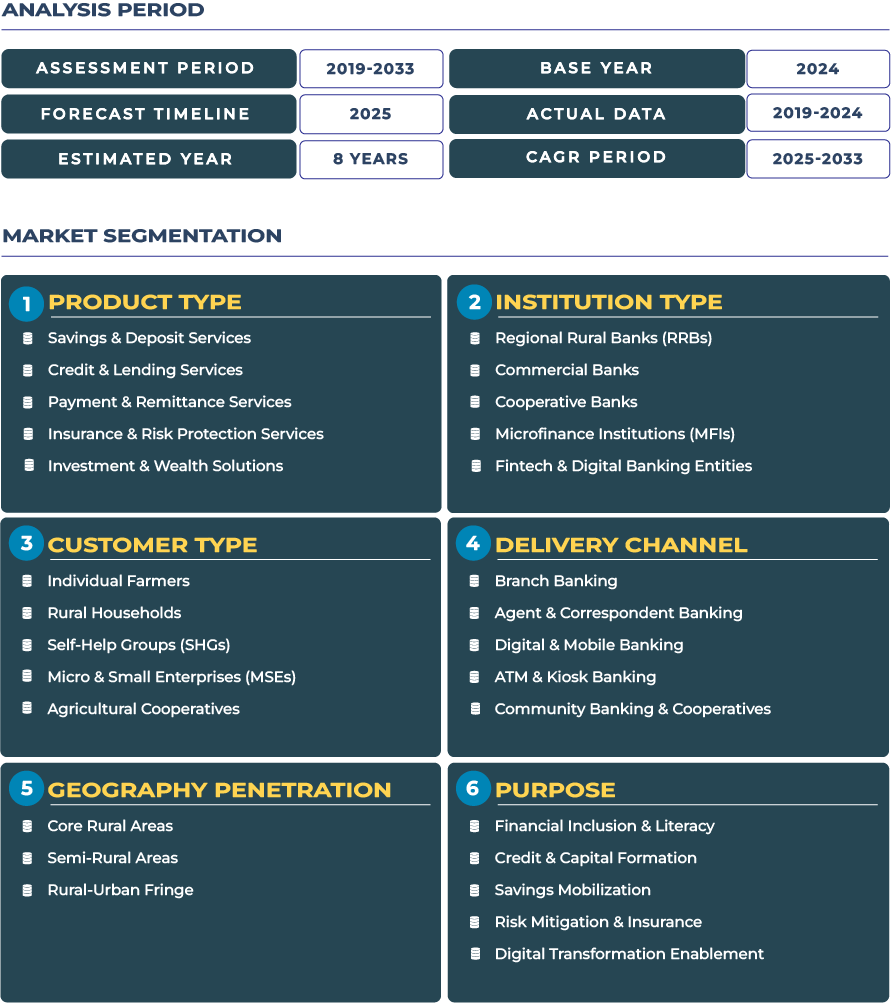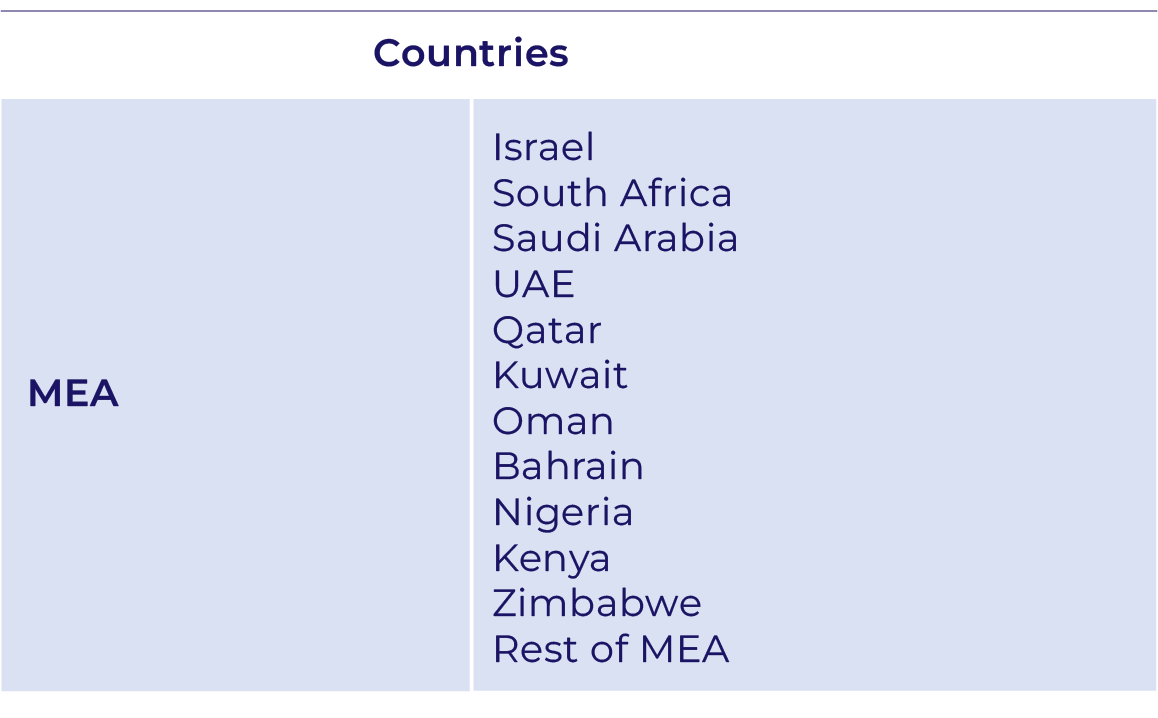Harnessing Islamic & Remittance-Driven Finance to Energise Rural Banking Across MEA
The rural banking landscape in the Middle East & Africa (MEA) region is being transformed through frameworks built on Sharia-compliant banking models and large remittance inflows that underpin financial inclusion in rural communities. In many countries within MEA, formal banking in underserved rural zones has historically been limited by infrastructure, geography and regulatory complexity. However, the emergence of Islamic finance vehicles, remittance-backed credit flows and micro-leasing models is creating new momentum for the rural banking industry. With the MEA rural banking market estimated at around USD 63.2 billion in 2025 and forecast to reach approximately USD 94.0 billion by 2033, representing a compound annual growth rate (CAGR) of about 5.1% from 2025 to 2033, the rural banking ecosystem is being repositioned from basic deposit-lending services toward comprehensive savings, payments, credit, insurance and investment solutions for rural populations.
Note:* The market size refers to the total fees/revenue generated by banks through various services.
MEA Rural Banking Market Outlook: Scaling Financial Inclusion by Deploying Sharia-Aligned & Remittance-Anchored Rural Banking Platforms
Across the MEA region, the rural banking sector enters a period of strategic acceleration, driven by demographic growth, migration patterns, digital payments and evolving regulatory frameworks. The forecast rise reflects a growing shift: banks and rural-finance institutions are increasingly integrating remittance-enabled deposit flows and Islamic-compliant credit products tailored to farming households, smallholder agribusinesses and rural micro-enterprises. Remittance channels keep rural households connected to formal banking via migrant workers abroad; banks can route savings and investment services to these networks, capturing rural liquidity that would otherwise remain informal. Simultaneously, Sharia-compliant rural micro-finance structures provide culturally-aligned credit and leasing models that resonate with many MEA communities. These factors combined, along with improving mobile-payment infrastructure, fintech penetration, and government-led inclusion policies, are expanding the rural banking ecosystem’s reach and enabling deeper product layering beyond traditional deposit-and-loan offerings. Nonetheless, growth is moderated by uneven country-level frameworks, subsidy dependencies and structural credit risks, but the CAGR underscores meaningful expansion potential rather than incremental stagnation.
Growth Catalysts: Migration-Remittance Flows, Fintech Penetration and Islamic-Finance Elevation in Rural Banking
A series of robust drivers are lifting the MEA rural banking market into higher gear. First, the remittance economy is a central lifeline for rural households across many MEA countries: banks that channel remittance inflows into rural deposit accounts, savings platforms and micro-investment vehicles are unlocking previously inaccessible rural liquidity pools. Second, fintech adoption is reshaping how rural banking services are delivered, mobile-first account onboarding, digital wallet remittances, agent networks and microcredit decisioning allow rural banks to reach remote communities cost-effectively. Third, the rise of Islamic-finance frameworks means that banks are offering sukuk-linked micro-leasing, takaful-based risk protection and Sharia-compliant wealth-solutions tailored for rural users, thereby addressing both regulatory and cultural drivers. Fourth, governments across MEA are emphasising rural financial inclusion, agricultural development, digital identity platforms and rural fintech infrastructure; for example, studies indicate that enhancing agricultural-finance ecosystems in Arab countries can reduce import dependency and strengthen rural banking backing. These factors jointly create favourable conditions for rural banking scale-up in MEA.
Structural Constraints: Conflict Zones, Operational Diversity and Credit-Risk Complexities Hampering Rural Banking Scale-Up
Despite the promising tailwinds, several constraints limit the pace of expansion in the MEA rural banking industry. The region comprises a wide spectrum of countries, from stable Gulf states to conflict-affected areas in Africa, resulting in highly heterogeneous regulatory, infrastructural and risk-landscape conditions. Conflict zones, political instability and natural-disaster exposure raise credit risk and absorb potential rural-banking investment. The legacy of informal rural finance, weak land-tenure systems, fragmented smallholder operations and limited collateral undermine credit-scoring models in many jurisdictions. Further, the heterogeneity of product demand, literacy levels, digital-access gaps and cross-border remittance regulation means rural-finance roll-outs cannot follow a one-size-fits-all approach. For example, agricultural-finance studies in Arab countries highlight the challenge of water scarcity, informal landholdings and limited institutional readiness. As a result, rural-banking institutions must manage higher operational overheads, design risk-mitigation frameworks and customise product suites to local ecosystems, which can dampen efficiency gains and moderate growth trajectories.
Emerging Trends & Strategic Opportunities: Mobile-Money Micro-Credit, Islamic Micro-Leasing and Remittance-Backed Rural Mortgages
The rural banking sector in MEA is witnessing several important trends and opportunities that present value-creation prospects for banks and fintechs alike. A dominant trend is mobile-money based micro-credit: rural banks and fintechs are launching digital platforms that allow remote savings pooling, micro-loan disbursement and repayment via mobile wallets, tailored to informal agricultural cash-flows and rural entrepreneurs. Another trend is the expansion of Islamic-compliant rural finance models, micro-leasing for small merchants in rural zones, takaful-wrapped credit for smallholder farmers and Sharia-aligned wealth-solutions for rural depositors. On the opportunity front, banks can deploy remittance-backed rural mortgages: many rural households receive predictable remittance inflows and can be offered mortgage or home-improvement finance secured against those flows, thereby expanding the asset-finance base. For instance, financing models that combine remittances, digital verification and rural collateral can open new asset classes for rural banking players. Moreover, by integrating insurance/risk-protection products (for crop failures, climate shocks) with credit and savings services, rural banks can build more resilient portfolios. Taken together, these trends define a platform-oriented rural banking ecosystem that goes beyond traditional deposit-and-loan, layering multiple services at scale.
Regional Analysis by Country
Saudi Arabia
In Saudi Arabia, rural banking is evolving under the aegis of regulatory reform and increasing fintech collaboration. Banks are exploring digital platforms for rural micro-finance and remittance-linked savings, supported by Islamic-finance frameworks and the Kingdom’s broader financial-inclusion agenda.Kuwait
In Kuwait, rural banking growth is constrained by small rural-population base, but banks are still developing rural deposit-mobilisation programmes and remittance-channelled wealth-solutions targeting expatriate workforce segments in rural areas.United Arab Emirates (UAE)
The UAE provides a regional fintech hub platform, which is enabling rural-banking outreach across surrounding regions: state-of-the-art digital rails, Sharia-compliant credit modules and rural remittance integration are expanding service coverage beyond urban centres.Oman
Oman rural banking ecosystem is aligned with agricultural diversification and micro-leasing for rural enterprises, offering banks a structured pathway to extend credit, savings and insurance services in sparsely populated hinterlands.Bahrain
In Bahrain, rural banking initiatives focus on fintech-enabled savings platforms and agent-networks in informal rural zones, leveraging the country’s regulatory sandbox environment to pilot micro-finance and remittance aggregation for rural users.Qatar
Qatar rural banking market opportunity is tied to overseas agrarian investments and remittance-flows from expatriate rural workers; banks are gradually developing rural-finance products backed by cross-border cash-flows and Islamic-finance structures.South Africa
South Africa has one of MEA’s most sophisticated rural banking markets: mobile-money integration, digital agent networks and rural micro-credit programmes are more advanced, yet still face high operational costs and legacy-credit risk across smallholder segments.Israel
In Israel, rural banking operates in a highly developed context, the focus is less on basic inclusion and more on innovation finance for farming cooperatives, agritech ventures and rural wealth-management services tailored to high-value agricultural zones.Nigeria
In Nigeria, the rural banking market is driven by mobile-money adoption, fintech-led agent networks and large remittance-flow ecosystems. However, rural credit-risk, infrastructure gaps and regulatory fragmentation remain constraints.Kenya
Kenya rural-banking ecosystem is strongly shaped by mobile banking (e.g., M-Pesa) and micro-finance. Banks and fintechs are extending savings and investment services into remote counties, often via digital wallets and agent networks.Zimbabwe
In Zimbabwe, rural banking is under-resourced but emerging opportunities exist through mobile-wallet remittances, commodity-linked credit (agrarian produce) and micro-insurance for rural farmers, though macro-economic volatility remains a major challenge.
Competitive Landscape: Launching Sharia-Micro-Leasing and Remittance-Backed Rural Mortgages to Win in the MEA Rural Banking Arena
Regional financial institutions and fintechs are actively deploying innovative strategies to capture the MEA rural banking opportunity. One major strategy is the rollout of Sharia-compliant micro-leasing programmes for small rural merchants and farmers. Institutions such as Al Baraka Banking Group (Al Baraka) are strengthening their rural-finance portfolios through Islamic credit, savings agents and digital platforms tailored for rural communities. Banks are also bundling rural insurance, savings and investment services into unified rural-client platforms, leveraging digital channels and partner networks to reduce cost-to-serve in remote regions. These strategic movements highlight how the rural banking sector in MEA is evolving from isolated lending operations to ecosystem-finance models that integrate remittances, digital payments, Islamic-finance compliance and rural asset-backed credit.








